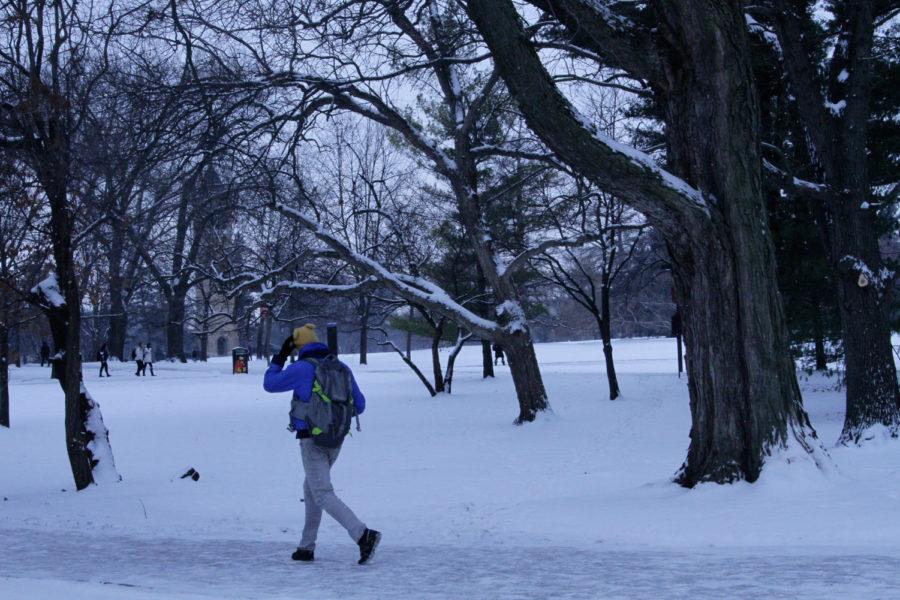Wandschneider: When temps drop, should classes stay in session?
Tiffany Herring/Iowa State Daily
A student walks to class through a snowstorm on Central Campus on Feb. 3. Columnist Wandschneider believes the university should consider canceling classes on days with brutal temperatures and wind chills in order to protect students walking from class to class.
February 5, 2014
Layers, layers, and more layers.
This seemed to be the trendiest attire last week as the students of Iowa State braved the cold blast. With a wind chill reaching around 30 degree below, it was hard to believe that classes were still on. When Monday’s alarms went off, emails were being constantly refreshed in hopes that we would not have to venture out across campus in Iowa’s frozen tundra.
To the students’ disappointment, classes were still in session. Cyride has reached maximum capacity with students trying to find some way around Mother Nature’s arctic blast. For those who braved the walk, hurried with their heads down, cutting through buildings allowed one way to minimize the time spent outdoors.
When temperatures plummet this low, the university should seriously consider canceling classes for the day. Many schools around the area were either delayed or cancelled due to these dangerous weather conditions. If the conditions were too dangerous for public schools to either start on time, or not start at all, then why was it safe enough for college students to have class?
Unlike elementary, middle school and high school students, college students have to walk outside in order to get from class to class. Rarely do students have all of their classes in one building. Not only are we constantly walking outside, our destination is usually a nice 10-minute trek. With the wind piercing through our layers, those 10 minutes can easily be the worst part of our day.
When wind chill reaches -19 degrees, people are susceptible to frostbite in as little as 30 minutes. Up the wind chill to -30 degrees, and we are looking at a 20- to 15-minute range. Now, anyone that is out that long in the extreme cold must be crazy, right? Unfortunately, that is the time range that most college students are out in the cold.
Walking quickly from one side of campus to the other takes approximately 15 minutes, which fits the time range to get frostbite. As adults, we know how to dress ourselves properly for such weather conditions, but even wearing a hat, gloves, and a warm winter coat will not prevent one from getting frostbite.
To answer students’ confusion about classes, the university posted this Facebook post on the Iowa State University page, “Just a reminder that unlike area school districts, the university cannot add extra days to the semester calendar. The Iowa State student population consists of adults, who can make their own decisions and communicate with instructors/supervisors to accommodate their concerns.”
This makes sense: If it is too cold to go to class, then stay inside where it is warm. But, in making that choice, students are being punished for it. Some classes have mandatory attendance. Nothing you say or do will allow you have an unexcused absence. Missing class because you feel it is too dangerous to go out and having classes canceled is practically the same thing. The only difference is that canceled classes would protect those who were unable to safely attend class.
Not only are students being protected from frostbite, they are also being protected from other illnesses that can come from being out in the cold for too long. It makes more sense to miss one day of class then have students miss multiple days because they are fighting a serious cold.
Some may still argue that in the real world, work does not get canceled due to dangerous temperatures. This is true, but in the real world, the most walking outside one will have to do is from car to building and then building to car at the end of the day. That would usually take someone no more than five minutes.
Even though we are all considered adults, we are still students. Our health and safety should be a priority. Classes should not be canceled each time that the temperatures swoops below zero, but when the weather is classified as dangerous, something should be done to help keep Iowa State students safe, whether it be canceling classes or preventing professors from counting unexcused absences. We live in Iowa, and winter is something that we all have to deal with, but sometimes it just gets too cold.







